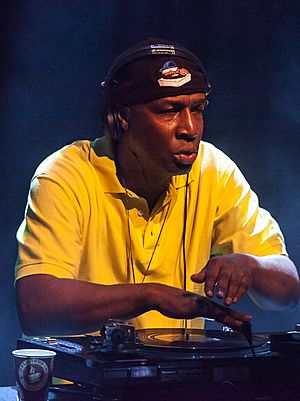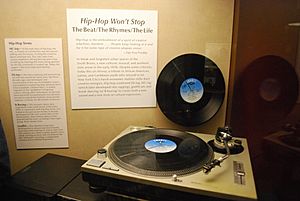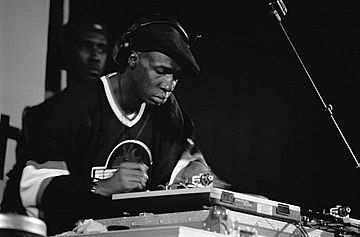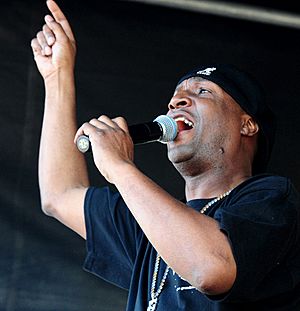Grandmaster Flash facts for kids
Quick facts for kids
Grandmaster Flash
|
|
|---|---|

Grandmaster Flash performing in 2014
|
|
| Background information | |
| Birth name | Joseph Robert Saddler |
| Born | January 1, 1958 Bridgetown, Barbados |
| Origin | The Bronx, New York City, U.S. |
| Genres |
|
| Occupations |
|
| Years active | 1978–present |
| Labels |
|
Joseph Robert Saddler (born January 1, 1958), better known by his stage name Grandmaster Flash, is a world-famous DJ from the United States. He is known as one of the pioneers of hip-hop music. He invented DJ techniques that changed music forever, including the Quick Mix Theory, which led to cutting and scratching records. He also invented the slipmat, a tool DJs still use today.
Grandmaster Flash started the group Grandmaster Flash and the Furious Five. In 2007, they became the first rap group ever to be welcomed into the Rock and Roll Hall of Fame. He has received many awards for his work. In 2019, he won the Polar Music Prize, a major music award from Sweden. He has also received honorary doctorate degrees, which are special awards from universities, for his impact on music and art.
Contents
Early Life and Musical Beginnings
Joseph Saddler was born in Barbados, and his family later moved to the Bronx in New York City. He went to a special high school where he learned how to fix electronics. This skill would become very useful later in his career.
His interest in music started at home. His father collected many records from the Caribbean and from African American artists. As a child, Joseph was fascinated by his father's record collection. He loved watching the records spin on the turntable. This early curiosity, along with his mother's encouragement to learn about electronics, sparked his passion for DJing. As a teenager, he started going to parties hosted by early DJs like DJ Kool Herc, where he learned about the growing music scene in New York.
How Grandmaster Flash Changed DJing

Grandmaster Flash was a true inventor. He studied how other DJs mixed songs and wanted to create a new, more exciting way to play music. He developed his own method called the Quick Mix Theory. This theory allowed him to find a short, exciting part of a song, like a drum beat, and play it over and over again without stopping. This created a continuous beat that was perfect for people to dance to and for rappers to perform over.
He developed several key techniques that are now fundamental to DJing:
- Quick-Mix Theory: DJs in the early days of hip-hop noticed that crowds loved the "break," a part of a song with just drums and percussion. Grandmaster Flash perfected a way to make this break last much longer. He used two turntables with two copies of the same record. Using his headphones, he would find the break on both records. When the break ended on one record, he would use a mixer to quickly switch to the other record, which was ready to play the same break. This created a seamless, endless loop of the best part of the song.
- The Slipmat: To make his quick mixes possible, Flash needed the records to spin freely without being slowed down by the turntable. He experimented with different materials and created the slipmat, a piece of felt that sits between the record and the turntable. This simple invention allowed him to spin records backward and forward smoothly, which was essential for his techniques.
- Punch Phrasing: This technique involved taking very short sounds, like a horn blast from a record, and "punching" them into the main beat at just the right time. This added a new layer of rhythm and excitement to the music.
- Scratching: While another DJ, Grand Wizzard Theodore, is often credited with discovering scratching, Grandmaster Flash perfected it. He showed how scratching—moving a record back and forth by hand to create a rhythmic sound—could be used as a musical instrument. Instead of just playing records, he was using the turntable to create brand new sounds.
Grandmaster Flash and the Furious Five
Forming the Group
In the late 1970s, Grandmaster Flash began working with rappers, who were also called MCs (Masters of Ceremony). He formed his own group, which eventually became known as Grandmaster Flash and the Furious Five. The members were Melle Mel, Kidd Creole, Cowboy, Scorpio, and Rahiem.
The group became famous for their amazing live shows. Cowboy is credited with creating the term "hip hop." He would chant "hip/hop/hip/hop" to match the rhythm of soldiers marching, and the name stuck. Melle Mel was the first rapper to call himself an "MC." The group's skillful raps and Flash's incredible DJing made them stars in the Bronx.
Rise to Fame
In 1981, the group released "The Adventures of Grandmaster Flash on the Wheels of Steel." This track was a masterpiece that showed off Flash's DJ skills. It mixed parts of songs from different artists like Queen and Blondie, and it was the first time record scratching was officially recorded.
A year later, in 1982, they released their most famous song, "The Message." Unlike other rap songs at the time, which were mostly about parties and fun, "The Message" had a serious tone. It described the difficult life and problems in inner-city neighborhoods. The song was a huge hit and proved that hip-hop could be used to talk about important social issues. In 2002, the Library of Congress added "The Message" to the National Recording Registry, calling it one of the most important recordings in American history.
Soon after the success of "The Message," disagreements within the group led them to split up. Grandmaster Flash and some members formed a new group, while Melle Mel and others continued as Grandmaster Melle Mel & the Furious Five. The original group did get back together for special performances years later.
Later Career and Legacy
Grandmaster Flash has continued to be a major figure in music. In 2008, he wrote a book about his life called The Adventures of Grandmaster Flash: My Life, My Beats. In the book, he shares stories about how he experimented with electronics and music as a kid.
He has appeared in video games like DJ Hero and was a character in the Netflix series The Get Down, which tells the story of the birth of hip-hop. In 2023, he even appeared on the TV show The Masked Singer as the "Polar Bear."
Grandmaster Flash's inventions and skills transformed the turntable from a machine that just plays music into an instrument that can create it. His work laid the foundation for hip-hop and continues to influence DJs and musicians all over the world.
Discography
Grandmaster Flash has released many albums and singles, both with the Furious Five and as a solo artist. Some of his most important albums include:
- The Message (1982)
- They Said It Couldn't Be Done (1985)
- The Bridge (Concept of a Culture) (2009)
Awards and Honors
Grandmaster Flash has received many awards for his contributions to music.
- Rock and Roll Hall of Fame: Inducted in 2007 with the Furious Five.
- Grammys: "The Message" was added to the Grammy Hall of Fame in 2012. He also received a Lifetime Achievement Award.
- Polar Music Prize: He won this prestigious award in 2019.
- BET Hip Hop Awards: Honored with the "I Am Hip Hop Icon Award" in 2006.
- Honorary Doctorates: He has received honorary degrees from Buffalo State University and Lehman College for his impact on culture.
Filmography
| Year | Title | Role | Notes |
|---|---|---|---|
| 2001 | Scratch | Himself | (archive footage) (as Grand Master Flash) |
See also
 In Spanish: Grandmaster Flash para niños
In Spanish: Grandmaster Flash para niños



